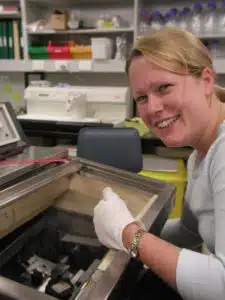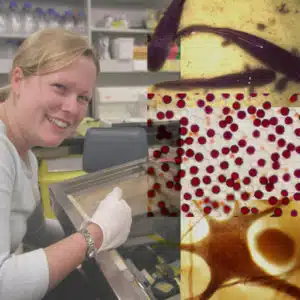The Australian lungfish-one of the world’s oldest fishes and related to our ancient ancestors-may have been viewing rivers in technicolour long before dinosaurs roamed the Earth.
Recent work by postgraduate student Helena Bailes at the University of Queensland has found these unusual fish have genes for five different forms of visual pigment in their eyes. Humans only have three.
Night and day (colour) vision are controlled by different light sensing cells known respectively as rods and cones. Humans have a single type of rod and three types of cone, each containing a different pigment gene tuned to red, green and blue wavelengths. Lungfish possess two additional pigments that were lost in mammals, Bailes says. They are tuned to longer wavelengths than in most other fish.
“Lungfish are very large, slow-moving fish, so vision was always assumed to be of little importance” she says. “This work may change that theory.”
Lungfish are ‘living fossils’ unchanged for over 100 million years. The Australian species (Neoceratodus forsteri) is the most primitive of the living lungfishes. It is a threatened species protected from fishing which lives in only a handful of rivers in south east Queensland.
“The only way to find out how the first creatures on land saw the world is to look at their closest living relative: the Australian lungfish,” Bailes says.
The photoreceptive cells, which house the visual pigments, are bigger in lungfish than for any other animal with a backbone. This probably makes them more sensitive to light.
“We keep discovering ways in which these animals are quite different from other fish,” Helena Bailes says. “Their eyes seem designed to optimise both sensitivity and colour vision with large cells containing different visual pigments.”
She now is hoping that behavioural research can find out how these fish are using their eyes for colour vision in the wild.
“We may then learn what Queensland rivers look like to some of their oldest inhabitants, before those inhabitants are wiped out,” Bailes says.
Helena is one of 13 Fresh Scientists who are presenting their research to the public for the first time thanks to Fresh Science, a national program sponsored by the Federal and Victorian Governments. One of the Fresh Scientists will win a trip to the UK courtesy of the British Council to present his or her work to the Royal Institution.

Helena working in her laboratory

Composite image, clockwise from top: Helena in the lab, Australian lungfish, retinal photoreceptors of lungfish, a retinal ganglion cell leading from the eye to the brain in lungfish

Australian lungfish




 Fresh Science is on hold for 2022. We will be back in 2023.
Fresh Science is on hold for 2022. We will be back in 2023.